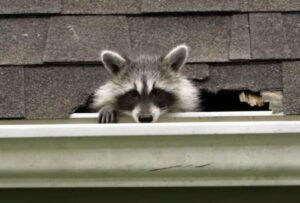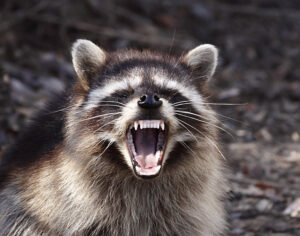Raccoon Trapping
Raccoon Removal Services, When You Need It!
Humane Raccoon Removal & Prevention
Raccoons are not particular about their habitat or the fact they might be living in a structure designed for humans. Raccoons have shown the ability to adapt to urban or suburban settings and commonly build dens inside homes & buildings. Raccoons only need a small opening or gap and will sometimes chew their way through openings in your fascia boards. As with bats, raccoons are primarily nocturnal critters and are on the prowl at night. Call (616) 836-4255 today and we’ll gladly confirm the presence of raccoons.
Identification Of Raccoons
 The raccoon is an intelligent, cunning animal that gets up to mischief with surprising enthusiasm. It is both vilified as a nuisance and loved for its fascinating behavior. It has thrived amid human activity when so many other species have declined in population. These creatures are among North America’s most well-known animals. It has a pointed snout, a broad skull, rounded ears, sharp teeth, a large hunched back (due to the hind legs being longer than the front legs), and a bushy tail with four to ten black rings. The raccoon’s most distinguishable characteristic is a black marking around the animal’s eyes that resembles a mask.
The raccoon is an intelligent, cunning animal that gets up to mischief with surprising enthusiasm. It is both vilified as a nuisance and loved for its fascinating behavior. It has thrived amid human activity when so many other species have declined in population. These creatures are among North America’s most well-known animals. It has a pointed snout, a broad skull, rounded ears, sharp teeth, a large hunched back (due to the hind legs being longer than the front legs), and a bushy tail with four to ten black rings. The raccoon’s most distinguishable characteristic is a black marking around the animal’s eyes that resembles a mask.
To keep warm, the raccoon’s coat is mainly made up of dense gray underfur. Raccoons are almost all the same color(gray, black, and white). Raccoons are about a small dog’s size, measuring between 2 and 3 feet long from tail to the skull and weighing 14 to 23 pounds. Males are approximately 10% to 30% larger than females. Their body weight varies greatly throughout the year, regardless of gender. In the winter, they gain weight, and in the summer, they lose it.
Urban & Rural Habitats Of Raccoons
Raccoons can be found in both rural and urban areas across Michigan. However, because they are most active at night, you are unlikely to see them during daylight hours. These native mammals tend to live in areas where there is a lot of tree cover and a water source. On the other hand, Raccoons have adapted to live in a variety of urban and suburban environments. Raccoons are often found near rivers, streams, and lakes in rural or sparsely populated areas. They can also be found in marshes and heavily forested or densely forested areas.
Raccoons have adapted their preferences to match human-made offerings where people have taken over. They are frequently found in urban areas near food sources, such as dumpsters, gardens, or parks, as well as in storm drains. Raccoons have what’s known as a “home range,” or a territory that they claim. The size of the raccoon’s range will be determined by the animal’s size, age, and location. The ranges of urban raccoons are often smaller than those of suburban or rural raccoons. A raccoon’s range can be anywhere from 1 square mile to 18 square miles in size.
What Attracts Raccoons To A Home?
 Like that of other small creatures, raccoons see a house as a potential shelter. It’s not uncommon to see small animals scurrying for warmth in a shed, garage, or attic when the weather turns cold in Michigan. Raccoons are no exception, and if it’s cold, rainy, or even snowing outside, they’ll do everything they can to stay warm and dry.
Like that of other small creatures, raccoons see a house as a potential shelter. It’s not uncommon to see small animals scurrying for warmth in a shed, garage, or attic when the weather turns cold in Michigan. Raccoons are no exception, and if it’s cold, rainy, or even snowing outside, they’ll do everything they can to stay warm and dry.
Garbage that is left outside adds to the appeal of houses. The majority of homeowners will have a designated trash day and dispose of their waste the night before. It is effortless for a gang of raccoons to get inside trash bins and help themselves to your leftovers if the trash cans do not have tops or secure locking mechanisms. If raccoons cannot locate trash cans around your home, they will seek out food left outside for a pet dog or cat. Again, because raccoons are known to carry rabies and will attack if provoked, it’s not a good idea to leave your pet’s food outside, as this can easily lead to an unpleasant encounter.
Signs Of Raccoons In The Attics
The level of noise coming from your attic will be enough to determine whether or not raccoons are in your attic. Smaller animals, such as mice and squirrels, make scratching, knawing, or scurrying sounds, whereas bats usually make no sound. Raccoons, on the other hand, will thrash and thump around due to their size and weight. It will sound like a tiny person rummaging around up there.
Evidence of debris in the attic is one telltale sign of their presence. If you have access to your attic and can take a quick look up there, you’ll be able to tell if raccoons are living there. They’ll almost certainly have made a mess getting into and out of the attic. In preparation for mating season, they will frequently rummage through your attic for nesting materials. Furthermore, raccoons typically use only one area of their living quarters as a restroom, so as unpleasant as it is to think about it, you will almost certainly smell or see evidence of feces/urine.
A mouse, bat, or squirrel can enter your home through a tiny opening the size of a dime, but a raccoon will need a much larger space. Because of their size and less-than-subtle approach, their entry point is often visible from ground level. To gain access, they frequently rip off a roof vent or bend back siding. If you suspect a raccoon has taken up residence in your attic, take a quick walk around the property and look for any signs of entry. It can be challenging to see all of your roof vents up close, so going onto a neighbor’s property to get a better view of your roof may help.
Raccoon Damage To The Home
Raccoons will create severe damage to your home once they’ve found a suitable nesting place (which includes your attic, chimney, crawl space under your property, and areas under porches and decking). Common raccoon damage includes:
- The garbage from your trash cans will be strewn about your property.
- To gain access to your attic space, they will remove shingles and fascia boards, and even damage vents.
- With nesting materials, they will obstruct chimneys.
- They’ll rip up siding, insulation, and anything else they can get their hands on to make their nest more ‘hospitable.’
- Garden crops will be stolen, and sod will be rolled up in search of worms, grubs, and insects to eat.
Diseases Carried By Raccoons
 A raccoon infestation in your home poses several health risks to you and your family. Rabies is a significant health risk, which is why it’s best to keep your distance and have the animal removed by a wildlife professional. Other raccoon-related health issues occur more indirectly. Raccoons may carry parasites such as mites and fleas, which can infest your home’s living areas.
A raccoon infestation in your home poses several health risks to you and your family. Rabies is a significant health risk, which is why it’s best to keep your distance and have the animal removed by a wildlife professional. Other raccoon-related health issues occur more indirectly. Raccoons may carry parasites such as mites and fleas, which can infest your home’s living areas.
Raccoon droppings pose the greatest threat because they can contain raccoon roundworm, which can cause serious health problems in humans, including blindness. Make sure you stay away from any areas of your home or attic where raccoon urine or feces may be present. Best Wat Animal Removal can safely clean up raccoon droppings with our biohazard cleaning services and eliminate the risk of raccoon roundworm.
Raccoon Removal & Exclusion
Trained raccoon control professionals should always conduct raccoon removal. Raccoons typically invade attics to raise their young, and a mother raccoon will attack if she feels her babies are being threatened. The wildlife removal experts at Best Way Animal Removal have the experience and tools to humanely remove and relocate a family of raccoons from your attic. The raccoon control & exclusion process includes the use of live traps that are designed to trap an entire family of raccoons. After all the raccoons are removed from the attic, our wildlife removal experts will identify the raccoons’ entry points and seal them to prevent future infestations.
Raccoon Removal Process
- A wildlife control expert is dispatched to your property and conducts a thorough inspection. The inspection will gather vital removal information such as how many raccoons, how the raccoons have gained entry, and the extent of the raccoon damage.
- We will form a strategic trapping and relocation plan specific to your property.
- Humane traps are set in high traffic raccoon areas.
- Once all of the raccoons are trapped, they are removed from the home.
- Entry points are sealed to ensure further infestations don’t occur.
- Our wildlife removal technician will advise on what repairs and decontamination services are needed.
- The animals are relocated far away and released in their proper habitat.
Do You Have Raccoons In The Attic?
We provide wild animal control services in Michigan, such as raccoon removal, raccoon control, and raccoon damage control services, as well as attic decontamination and insulation repair. Have you heard scratching noises, loud banging, or someone walking around in the walls or attic of your Michigan home or business? If that’s the case, you might have a raccoon problem. Don’t hesitate to call us because the longer raccoons reside in your home; the more costly damage will occur.
Areas Serviced For Raccoon Removal & Prevention
Allegan County, MI
Allegan, Douglas, Fennville, Holland, Hopkins, Martin, Otsego, Plainwell, Saugatuck, South Haven, Wayland
Kent County, MI
Byron Center, Caledonia, Casnovia, Cedar Springs, Comstock Park, Cutlerville, East Grand Rapids, Forest Hills, Grand Rapids, Grandville, Kent City, Kentwood, Lowell, Northview, Rockford, Sand Lake, Sparta, Walker, Wyoming
Muskegon County, MI
Casnovia, Fruitport, Lakewood Club, Montague, Muskegon, Muskegon Heights, North Muskegon, Norton Shores, Ravenna, Roosevelt Park, Twin Lake, Whitehall, Wolf Lake
Ottawa County, MI
Coopersville, Ferrysburg, Grand Haven, Holland, Hudsonville, Zeeland, Spring Lake, Allendale, Beechwood, Jenison, Agnew, Bauer, Beaverdam, Big Spring, Blendon, Borculo, Conger, Conklin, Crisp, Crockery Lake, Dennison, Drenthe, Eastmanville, East Allendale, Finnasey, Forest Grove, Gooding, Grand Valley, Harlem Station, Harrisburg, Herrington, Jamestown, Lamont, Lisbon, Macatawa, Marne, North Blendon, Nunica, Ottawa Center, Pearline, Port Sheldon, Reno, Robinson, Spoonville, Tallmadge, Vriesland, West Olive, Wright
